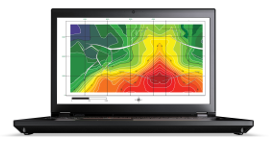ThinkPad aficionados, are you ready?
While both bending the language and changing definitions of hardware on the fly, Lenovo announced on Tuesday the Lenovo ThinkPad P50 and P70, the new ThinkPad hardware to be available in Q4.
But first, let’s set things straight: The ThinkPad is no longer a laptop, according to the Lenovo press release. The first paragraph of the press release says the company “unveiled the beginning of a new family of mobile workstation innovations.” So I guess that’s what we’re calling them now – mobile workstations.

Anyway, the new ThinkPad P70 comes with the most memory and storage ever found in a laptop…sorry, a mobile workstation. Namely, maxing out at 64GB of DDR4 ECC memory and with the ability to handle up to four storage devices and up to a terabyte of SSD storage. It also utilizes the latest PCIe technology for speeds up to five times faster than current SATA technology. But wait, there’s more: The ThinkPad P70 “comes with two Intel ThunderboltTM 3 ports for ultra-fast connectivity and a 4K UHD display or optional FHD touch,” according to the release.
The little-sibling ThinkPad P50 features a beautiful 15.6-inch UHD 4K display and is a feature-rich, highly powerful mobile workstation for performance-seeking users. As the follow-up to the ThinkPad W541, the P50 builds on the innovation and purposeful design of Lenovo’s industry-leading ThinkPad mobile workstations.
According to the release, the new ThinkPad P50 and P70 are the first equipped with the new Intel Xeon Processor E3-1500M v5 product family, for lightning-fast performance and enhanced reliability for critical workstation applications. Both systems feature NVIDIA Quadro GPUs for unmatched graphics capability. The ThinkPad P Series also come with X-Rite Pantone color calibration, keeping colors accurate throughout the life of the product and protecting the customers’ investment.

The $64,000 question is the operating system. The ThinkPad P Series comes with Windows 10, of course, but Ubuntu and Red Hat Enterprise Linux are also available.
The new Lenovo ThinkPad P Series mobile workstations will be available starting in Q4 2015 through Lenovo business partners and the Lenovo site. Pricing for the P50 begins at $1599, and the P70 begins at $1999. More information about the ThinkPad P Series can be found on Lenovo’s interactive page. If you want to pass “go” and collect $200 while going directly to the specs, here are the P50 specs and here are the P70 specs (and ignore the “Lenovo recommends Windows” at the top of the page. Sheesh).
Help keep FOSS Force strong. If you like this article, become a subscriber.






More important question. Will it come with a full-featured keyboard and a full three button mouse?
Two of the features that made ThinkPads big in the community
I got servers with 2 xeons and six small fans for cooling which make a lot of noise. The P50 has a xeon, needs cooling, has a nvidia quadro, needs cooling. With the need for cooling, how are are they gonna keep’em from takin’ off your lap?
Lenovo at it again:
https://news.ycombinator.com/item?id=10039870
This time they are root-kitting machines via malicious code in their BIOS.
@Mac Taylor: remeber, these are not laptops but “mobile workstations”, you’re probably not suposed to put them in your lap 🙂
And to add to Mike’s comment:
http://www.osnews.com/story/28774/Lenovo_used_firmware_to_install_persistent_crapware
http://arstechnica.com/information-technology/2015/08/lenovo-used-windows-anti-theft-feature-to-install-persistent-crapware/
Bad Lenovo…
I have a W530 which has 24GB of memory, capable of supporting 32GB, which I bought new in December, 2012 with Windows 8 Pro. That machine has the 2 GB NVIDIA K1000M video card, which was their stock video card until 2014. The system works fine running Ubuntu natively, but the Ubuntu nouveau driver is not as good as the NVIDIA Windows version; But that was 2013, perhaps the gnu/linux version of the driver is better now. Currently I use Windows 10 on it and run OpenBSD & FreeBSD as 64bit VM’s; When running virtually, I think that OpenBSD is much better than FreeBSD, but I have had issues with GNOME3 when trying to use it on OpenBSD VM. GNOME3 works fine with OpenBSD, when I run OpenBSD natively on my 9 year old Compaq box with a 64bit AMD procesor.
“Mobile workstation” is not a new term. It’s been around for several years. It is not supposed to be a sustitute term for a laptop, but rather a class of laptop. A “mobile worstation” class laptop is supposed to be powerful enough to substitute for a powerful desktop. The goal for one is power without regard to battery life and only a nod to portability.
There are no hard and fast rules, of course, but generally a “mobile workstation” now will probably have at least a 15.6 inch full HD screen, a 4 core processor, 8 GB of RAM (perhaps even 16), and a discrete video card. The biggest difference between a “mobile workstation” class model and a “gamer’s laptop” is that generally the video card will be the business model (like the Nvidia Quadro or the AMD FirePro) and the CPU may be a mobile version of a workstation/server class CPU (like a Xeon), but not always. Also “mobile workstations” generally have to pass a more extensive ruggedness test.
Most importantly, will they include the unremovable spyware in these, too?
According to Lenovo, only the consumer hardware is affected, not the ThinkPads:
http://news.lenovo.com/article_display.cfm?article_id=2013